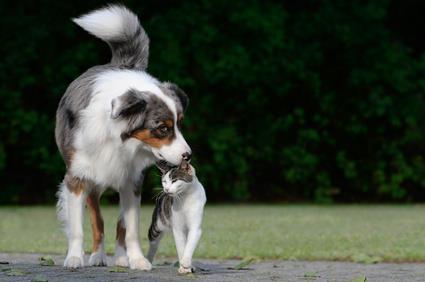For a long time, it has been generally accepted that cats and dogs naturally don’t get along well. And there is no smoke without fire. Even if your dog is not at all aggressive, his or her active approach to greeting and “hugging” may be too much for your cat to take. This may end either in the cat being chased into the corner or under the bed or with your dog’s nose scratched. But can it be the other way round? Can cats and dogs become friends? Of course.
In this article you’ll learn how to help your cat and dog to get along and the 6 steps to introduce your cat to your dog.

There is no doubt that dogs and cats can become friends; otherwise we wouldn’t have the Internet flooded with pics of cats and dogs happily snuggling together. Even our own cat likes to groom our dog’s face, and many pet owners report equally friendly attitudes. And you can achieve that too.
IMPORTANT: If your dog is aggressive toward your cat, you must physically separate both animals, provide a safe environment for the cat, and refer to a professional dog trainer for the sake of your cat’s safety. The tips below are intended for cases when the dog is overly enthusiastic when seeing the cat, which creates fear and aggression responses in the cat.
All dates must be well prepared
The best approach to helping your pets become friends is to start from scratch. Have your dog and cat refresh their relationship, and introduce them properly, as if they have never met before. And to achieve that, there are several prerequisites that must be met:
- Separate the animals physically. If you have a dog and a cat who do not get along well, it’s likely you have already done this. It’s crucial that they are not around each other at all times. What you will need is to create supervised introduction sessions that are filled with positive experiences. Think of it as “dating,” which includes all the fun, but leaves out the boredom and everyday stress.
 Train your dog in basic commands. You don’t have to teach your dog unconditional obedience, but she should know basic commands such as “come,” “sit,” “lie,” and “heel.” They will help you to handle your dog more easily during the introductions, but even more important, training improves your communication with your dog. Besides, if you have mastered basic training, you will be very likely to understand how better to train your dog to get along with your cat.
Train your dog in basic commands. You don’t have to teach your dog unconditional obedience, but she should know basic commands such as “come,” “sit,” “lie,” and “heel.” They will help you to handle your dog more easily during the introductions, but even more important, training improves your communication with your dog. Besides, if you have mastered basic training, you will be very likely to understand how better to train your dog to get along with your cat.- Provide vertical territory for your cat. Unlike dogs, cats are not that easily trained, and making your cat sit when a dog enters is not a good idea. Instead, let him climb up. Make some furniture tops available to your cat, get a cat tree, or install shelves and perches on the walls. This not only stimulates your cat’s natural behaviors, but it also makes it possible for your cat to stay out of your dog’s reach. NOTE: Even if your cat is the aggressive one, most likely he is acting this way because he has no place to retreat to. This is what cats do; they attack only when there is no other option.
- Provide enough exercise for both of your pets on a daily basis. Yes, daily. Your pets are animals, and they need to expel energy (just like you do) to feel well. It might be a good idea to play with your cat and walk with your dog at least once a day, but if you feel that’s too boring, here are two articles: How to spend time with your dog, and How to keep your cat active.
- Provide scent introductions. If you are able to separate your pets, you are already giving them the ability to get to “meet” each other through scent. One thing that happens pretty automatically is that they can smell and hear each other through the door if they live in the same house. But you can also put a blanket in places where each of animals sleeps and swap the blankets after a few days. You can brush both animals with the same comb, or let them smell each other through other items such as toys. Another option is to take the cat out of the room and let the dog inside, and in the meantime, let the cat explore the dog’s territory.
- Polish your own observation skills. Even though this article explains how to train your cat and dog to get along in a “step-by-step” manner, in reality, it’s more of a “do-observe-alternate” method. The most important skill you will need is an ability to translate your pets’ body language and understand when the introduction process can be intensified and when your pace must be slowed down.
6 steps to introduce your cat to your dog
Introducing your cat to your dog is a slow and steady walk. The longer you have your pets separated and without visual contact, the easier the introductions will go. But once you feel ready, here is how to introduce your dog to your cat:
- Always make introduction sessions short and end them in a positive way. There is no need to fast-forward. If you want, you can have several short sessions per day, rather than one longer session that ends in fighting or “arguing.” For perspective, in human relationships, if a date ends with a fight, it is usually the last date. But you do want a second and a tenth date. You also want your pets to “move in” together and live as a happy family. So make sure the date ends before your pets become aggressive. BEFORE, not after.
- Exercise with your pets before the introduction. There’s a huge difference in whether you try to present a cat to a dog who is all high on energy or to one who is tired. The best course is to have a long walk with your dog while someone plays with the cat at the same time. If that’s not possible, first, play with the cat, and then walk with the dog. Or you can do it in reverse if your inner detective tells you that it suits your pets better.
- Let both animals observe each other from a distance. If you don’t know how your pets are going to react (or if you know exactly how they are going to react), it’s safer not to allow your pets to come into contact during the first session and perhaps some sessions after that. Even if it seems that your dog and cat accept each other’s presence well, it’s safer not to rush. There is no single best approach, but these are a few of the most plausible ones.
 Have the cat on a cat tree while the dog explores the room. In nature, cats climb trees to be safe from other predators. Place your cat (or let her climb) on a cat tree and let the dog inside. Your cat will feel secure and will be able to observe the dog, without getting into its jaws (or hugs). If the tension is high, you can put your dog on a leash while he explores the room.
Have the cat on a cat tree while the dog explores the room. In nature, cats climb trees to be safe from other predators. Place your cat (or let her climb) on a cat tree and let the dog inside. Your cat will feel secure and will be able to observe the dog, without getting into its jaws (or hugs). If the tension is high, you can put your dog on a leash while he explores the room.- Place a baby gate in between the animals. Unless your dog is going to jump over it, place a gate in the door of the room where the cat resides. Now your dog can come next to the cat, but no closer, whereas the cat can manage the distance depending on his own fear/curiosity ratio.
- Redirect the attention of both animals. During the first introduction sessions, you don’t want your cat and dog to actively engage. Most likely, you need them to be “aware” of each other while being focused on something else. Playing and eating are the most plausible choices. But remember that this is not as easy as it sounds, because holding a cat’s or dog’s attention is hard if another previously unseen pet is nearby.
- Reward good behavior. This applies more to the dog, and holds true whether the dog is aggressive or too enthusiastic. Whenever your dog is calm, provide him or her with a treat and praise. If you have taught your dog basic commands as recommended, this will be easy for you to understand and implement.
- End the session if either of the animals displays aggression. Or no…better stop it BEFORE that happens. Have some fun time, and as you see the tension building up (this is why you need to understand the body language of both animals), end the session on a positive tone. If aggression happens, stop the session, and make the next one significantly shorter, with a larger distance between your pets. You can even take some days off and have the animals separate to lower the tension.
Repeat the above steps as often as you can, introducing your pets in slow motion. Let your dog and cat build their familiarity by a fraction every time, gradually make the sessions slightly longer, and let the pets get an inch closer each day. Soon you may notice that your cat and dog become best buddies after all.
